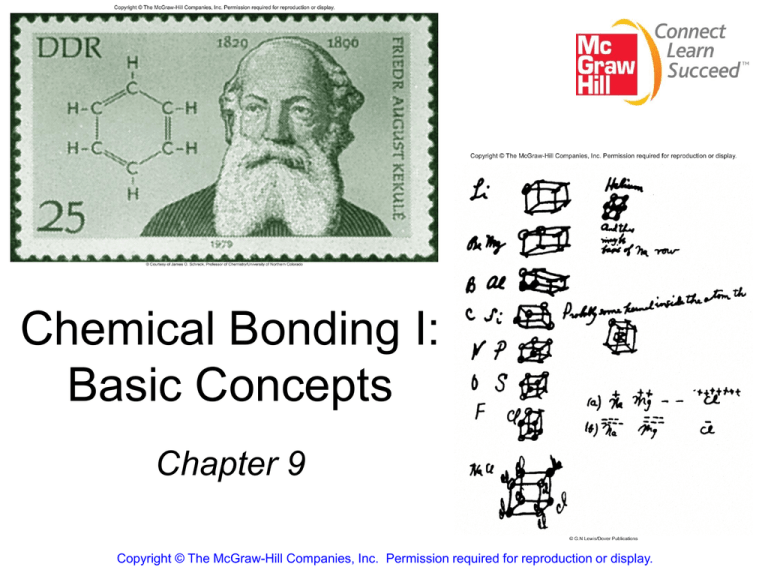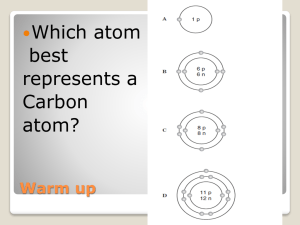Chapter_9_Chemical_Bonding_I
advertisement

Chemical Bonding I: Basic Concepts Chapter 9 Copyright © The McGraw-Hill Companies, Inc. Permission required for reproduction or display. Valence electrons are the outer shell electrons of an atom. The valence electrons are the electrons that participate in chemical bonding. Group e- configuration # of valence e- 1A ns1 1 2A ns2 2 3A ns2np1 3 4A ns2np2 4 5A ns2np3 5 6A ns2np4 6 7A ns2np5 7 2 Lewis Dot Symbols for the Representative Elements & Noble Gases 3 The Ionic Bond Ionic bond: the electrostatic force that holds ions together in an ionic compound. Li+ F Li + F 1s22s1 LiF 1s22s22p5 Li+ + e- Li e- + Li+ + 1s2 1s22s22p6 [He] [Ne] F F - F - Li+ F - 4 Example 9.1 Use Lewis dot symbols to show the formation of aluminum oxide (Al2O3). The mineral corundum (Al2O3). Example 9.1 Strategy We use electroneutrality as our guide in writing formulas for ionic compounds, that is, the total positive charges on the cations must be equal to the total negative charges on the anions. Solution According to Figure 9.1, the Lewis dot symbols of Al and O are Because aluminum tends to form the cation (Al3+) and oxygen the anion (O2−) in ionic compounds, the transfer of electrons is from Al to O. There are three valence electrons in each Al atom; each O atom needs two electrons to form the O2− ion, which is isoelectronic with neon. Example 9.1 Thus, the simplest neutralizing ratio of Al3+ to O2− is 2:3; two Al3+ ions have a total charge of +6, and three O2− ions have a total charge of −6. So the empirical formula of aluminum oxide is Al2O3, and the reaction is Check Make sure that the number of valence electrons (24) is the same on both sides of the equation. Are the subscripts in Al2O3 reduced to the smallest possible whole numbers? Electrostatic (Lattice) Energy Lattice energy (U) is the energy required to completely separate one mole of a solid ionic compound into gaseous ions. Q+Q E=k r Lattice energy increases as Q increases and/or as r decreases. E is the potential energy Q+ is the charge on the cation Q- is the charge on the anion r is the distance between the ions Compound Lattice Energy (kJ/mol) Q: +2,-1 MgF2 2957 Q: +2,-2 MgO 3938 LiF LiCl 1036 853 r F- < r Cl8 Born-Haber Cycle for Determining Lattice Energy o DHoverall = DHo1 + DHo2 + DHo3 + DHo4 + DHo5 9 10 Chemistry In Action: Sodium Chloride: A Common and Important Compound Mining Salt Solar Evaporation for Salt 11 A covalent bond is a chemical bond in which two or more electrons are shared by two atoms. Why should two atoms share electrons? F + 7e- F F F 7e- 8e- 8e- Lewis structure of F2 single covalent bond lone pairs F F lone pairs single covalent bond lone pairs F F lone pairs 12 Lewis structure of water H + O + H single covalent bonds H O H or H O H 2e- 8e- 2e- Double bond – two atoms share two pairs of electrons O C O or O O C double bonds 8e- 8e- 8e- Triple bond – two atoms share three pairs of electrons N N 8e-8e- or N N triple bond 13 Lengths of Covalent Bonds Bond Lengths Triple bond < Double Bond < Single Bond 14 15 Polar covalent bond or polar bond is a covalent bond with greater electron density around one of the two atoms electron poor region H electron rich region F e- poor H d+ e- rich F d- 16 Electronegativity is the ability of an atom to attract toward itself the electrons in a chemical bond. Electron Affinity - measurable, Cl is highest X (g) + e- X-(g) Electronegativity - relative, F is highest 17 The Electronegativities of Common Elements 18 Variation of Electronegativity with Atomic Number 19 Classification of bonds by difference in electronegativity Difference Bond Type 0 Covalent 2 0 < and <2 Ionic Polar Covalent Increasing difference in electronegativity Covalent Polar Covalent share e- partial transfer of e- Ionic transfer e20 Example 9.2 Classify the following bonds as ionic, polar covalent, or covalent: (a) the bond in HCl (b) The bond in KF (c) the CC bond in H3CCH3 Example 9.2 Strategy We follow the 2.0 rule of electronegativity difference and look up the values in Figure 9.5. Solution (a) The electronegativity difference between H and Cl is 0.9, which is appreciable but not large enough (by the 2.0 rule) to qualify HCl as an ionic compound. Therefore, the bond between H and Cl is polar covalent. (b) The electronegativity difference between K and F is 3.2, which is well above the 2.0 mark; therefore, the bond between K and F is ionic. (c) The two C atoms are identical in every respect—they are bonded to each other and each is bonded to three other H atoms. Therefore, the bond between them is purely covalent. Writing Lewis Structures 1. Draw skeletal structure of compound showing what atoms are bonded to each other. Put least electronegative element in the center. 2. Count total number of valence e-. Add 1 for each negative charge. Subtract 1 for each positive charge. 3. Complete an octet for all atoms except hydrogen. 4. If structure contains too many electrons, form double and triple bonds on central atom as needed. 23 Example 9.3 Write the Lewis structure for nitrogen trifluoride (NF3) in which all three F atoms are bonded to the N atom. NF3 is a colorless, odorless, unreactive gas. Example 9.3 Solution We follow the preceding procedure for writing Lewis structures. Step 1: The N atom is less electronegative than F, so the skeletal structure of NF3 is Step 2: The outer-shell electron configurations of N and F are 2s22p3 and 2s22p5, respectively. Thus, there are 5 + (3 × 7), or 26, valence electrons to account for in NF3. Example 9.3 Step 3: We draw a single covalent bond between N and each F, and complete the octets for the F atoms. We place the remaining two electrons on N: Because this structure satisfies the octet rule for all the atoms, step 4 is not required. Check Count the valence electrons in NF3 (in bonds and in lone pairs). The result is 26, the same as the total number of valence electrons on three F atoms (3 × 7 = 21) and one N atom (5). Example 9.4 Write the Lewis structure for nitric acid (HNO3) in which the three O atoms are bonded to the central N atom and the ionizable H atom is bonded to one of the O atoms. HNO3 is a strong electrolyte. Example 9.4 Solution We follow the procedure already outlined for writing Lewis structures. Step 1: The skeletal structure of HNO3 is Step 2: The outer-shell electron configurations of N, O, and H are 2s22p3, 2s22p4, and 1s1, respectively. Thus, there are 5 + (3 × 6) + 1, or 24, valence electrons to account for in HNO3. Example 9.4 Step 3: We draw a single covalent bond between N and each of the three O atoms and between one O atom and the H atom. Then we fill in electrons to comply with the octet rule for the O atoms: Step 4: We see that this structure satisfies the octet rule for all the O atoms but not for the N atom. The N atom has only six electrons. Therefore, we move a lone pair from one of the end O atoms to form another bond with N. Example 9.4 Now the octet rule is also satisfied for the N atom: Check Make sure that all the atoms (except H) satisfy the octet rule. Count the valence electrons in HNO3 (in bonds and in lone pairs). The result is 24, the same as the total number of valence electrons on three O atoms (3 × 6 = 18), one N atom (5), and one H atom (1). Example 9.5 Write the Lewis structure for the carbonate ion ( ). Example 9.5 Solution We follow the preceding procedure for writing Lewis structures and note that this is an anion with two negative charges. Step 1: We can deduce the skeletal structure of the carbonate ion by recognizing that C is less electronegative than O. Therefore, it is most likely to occupy a central position as follows: Example 9.5 Step 2: The outer-shell electron configurations of C and O are 2s22p2 and 2s22p4, respectively, and the ion itself has two negative charges. Thus, the total number of electrons is 4 + (3 × 6) + 2, or 24. Step 3: We draw a single covalent bond between C and each O and comply with the octet rule for the O atoms: This structure shows all 24 electrons. Example 9.5 Step 4: Although the octet rule is satisfied for the O atoms, it is not for the C atom. Therefore, we move a lone pair from one of the O atoms to form another bond with C. Now the octet rule is also satisfied for the C atom: Check Make sure that all the atoms satisfy the octet rule. Count the valence electrons in (in chemical bonds and in lone pairs). The result is 24, the same as the total number of valence electrons on three O atoms (3 × 6 = 18), one C atom (4), and two negative charges (2). Two possible skeletal structures of formaldehyde (CH2O) H C O H H C H O An atom’s formal charge is the difference between the number of valence electrons in an isolated atom and the number of electrons assigned to that atom in a Lewis structure. formal charge on an atom in a Lewis structure = total number total number of valence of nonbonding electrons in electrons the free atom - 1 2 ( total number of bonding electrons ) The sum of the formal charges of the atoms in a molecule or ion must equal the charge on the molecule or ion. 35 H -1 +1 C O formal charge on an atom in a Lewis structure H = C – 4 eO – 6 e2H – 2x1 e12 e- 2 single bonds (2x2) = 4 1 double bond = 4 2 lone pairs (2x2) = 4 Total = 12 total number total number of valence of nonbonding electrons in electrons the free atom - 1 2 ( total number of bonding electrons ) formal charge = 4 -2 -½ x 6 = -1 on C formal charge = 6 -2 -½ x 6 = +1 on O 36 H H 0 C formal charge on an atom in a Lewis structure 0 O = C – 4 eO – 6 e2H – 2x1 e12 e- 2 single bonds (2x2) = 4 1 double bond = 4 2 lone pairs (2x2) = 4 Total = 12 total number total number of valence of nonbonding electrons in electrons the free atom - 1 2 ( total number of bonding electrons ) formal charge = 4 - 0 -½ x 8 = 0 on C formal charge = 6 -4 -½ x 4 = 0 on O 37 Example 9.6 Write formal charges for the carbonate ion. Example 9.6 Strategy The Lewis structure for the carbonate ion was developed in Example 9.5: The formal charges on the atoms can be calculated using the given procedure. Solution We subtract the number of nonbonding electrons and half of the bonding electrons from the valence electrons of each atom. Example 9.6 The C atom: The C atom has four valence electrons and there are no nonbonding electrons on the atom in the Lewis structure. The breaking of the double bond and two single bonds results in the transfer of four electrons to the C atom. Therefore, the formal charge is 4 − 4 = 0. The O atom in C=O: The O atom has six valence electrons and there are four nonbonding electrons on the atom. The breaking of the double bond results in the transfer of two electrons to the O atom. Here the formal charge is 6 − 4 − 2 = 0. Example 9.6 The O atom in C−O: This atom has six nonbonding electrons and the breaking of the single bond transfers another electron to it. Therefore, the formal charge is 6 − 6 − 1 = −1. Thus, the Lewis structure for with formal charges is Check Note that the sum of the formal charges is −2, the same as the charge on the carbonate ion. Formal Charge and Lewis Structures 1. For neutral molecules, a Lewis structure in which there are no formal charges is preferable to one in which formal charges are present. 2. Lewis structures with large formal charges are less plausible than those with small formal charges. 3. Among Lewis structures having similar distributions of formal charges, the most plausible structure is the one in which negative formal charges are placed on the more electronegative atoms. 42 Example 9.7 Formaldehyde (CH2O), a liquid with a disagreeable odor, traditionally has been used to preserve laboratory specimens. Draw the most likely Lewis structure for the compound. Example 9.7 Strategy A plausible Lewis structure should satisfy the octet rule for all the elements, except H, and have the formal charges (if any) distributed according to electronegativity guidelines. Solution The two possible skeletal structures are Example 9.7 First we draw the Lewis structures for each of these possibilities To show the formal charges, we follow the procedure given in Example 9.6. In (a) the C atom has a total of five electrons (one lone pair plus three electrons from the breaking of a single and a double bond). Because C has four valence electrons, the formal charge on the atom is 4 − 5 = −1. The O atom has a total of five electrons (one lone pair and three electrons from the breaking of a single and a double bond). Since O has six valence electrons, the formal charge on the atom is 6 − 5 = +1. Example 9.7 In (b) the C atom has a total of four electrons from the breaking of two single bonds and a double bond, so its formal charge is 4 − 4 = 0. The O atom has a total of six electrons (two lone pairs and two electrons from the breaking of the double bond). Therefore, the formal charge on the atom is 6 − 6 = 0. Although both structures satisfy the octet rule, (b) is the more likely structure because it carries no formal charges. Check In each case make sure that the total number of valence electrons is 12. Can you suggest two other reasons why (a) is less plausible? A resonance structure is one of two or more Lewis structures for a single molecule that cannot be represented accurately by only one Lewis structure. O O + O O + O O 47 Example 9.8 Draw three resonance structures for the molecule nitrous oxide, N2O (the atomic arrangement is NNO). Indicate formal charges. Rank the structures in their relative importance to the overall properties of the molecule. Example 9.8 Strategy The skeletal structure for N2O is We follow the procedure used for drawing Lewis structures and calculating formal charges in Examples 9.5 and 9.6. Solution The three resonance structures are Example 9.8 We see that all three structures show formal charges. Structure (b) is the most important one because the negative charge is on the more electronegative oxygen atom. Structure (c) is the least important one because it has a larger separation of formal charges. Also, the positive charge is on the more electronegative oxygen atom. Check Make sure there is no change in the positions of the atoms in the structures. Because N has five valence electrons and O has six valence electrons, the total number of valence electrons is 5 × 2 + 6 = 16. The sum of formal charges is zero in each structure. Exceptions to the Octet Rule The Incomplete Octet BeH2 BF3 B – 3e3F – 3x7e24e- Be – 2e2H – 2x1e4e- F B H F Be H 3 single bonds (3x2) = 6 9 lone pairs (9x2) = 18 Total = 24 F 51 Exceptions to the Octet Rule Odd-Electron Molecules NO N – 5eO – 6e11e- N O The Expanded Octet (central atom with principal quantum number n > 2) SF6 S – 6e6F – 42e48e- F F F S F F F 6 single bonds (6x2) = 12 18 lone pairs (18x2) = 36 Total = 48 52 Example 9.9 Draw the Lewis structure for aluminum triiodide (AlI3). AlI3 has a tendency to dimerize or form two units as Al2I6. Example 9.9 Strategy We follow the procedures used in Examples 9.5 and 9.6 to draw the Lewis structure and calculate formal charges. Solution The outer-shell electron configurations of Al and I are 3s23p1 and 5s25p5, respectively. The total number of valence electrons is 3 + 3 × 7 or 24. Because Al is less electronegative than I, it occupies a central position and forms three bonds with the I atoms: Note that there are no formal charges on the Al and I atoms. Example 9.9 Check Although the octet rule is satisfied for the I atoms, there are only six valence electrons around the Al atom. Thus, AlI3 is an example of the incomplete octet. Example 9.10 Draw the Lewis structure for phosphorus pentafluoride (PF5), in which all five F atoms are bonded to the central P atom. PF5 is a reactive gaseous compound. Example 9.10 Strategy Note that P is a third-period element. We follow the procedures given in Examples 9.5 and 9.6 to draw the Lewis structure and calculate formal charges. Solution The outer-shell electron configurations for P and F are 3s23p3 and 2s22p5, respectively, and so the total number of valence electrons is 5 + (5 × 7), or 40. Phosphorus, like sulfur, is a third-period element, and therefore it can have an expanded octet. Example 9.10 The Lewis structure of PF5 is Note that there are no formal charges on the P and F atoms. Check Although the octet rule is satisfied for the F atoms, there are 10 valence electrons around the P atom, giving it an expanded octet. Example 9.11 Draw a Lewis structure for the sulfate ion in which all four O atoms are bonded to the central S atom. Example 9.11 Strategy Note that S is a third-period element. We follow the procedures given in Examples 9.5 and 9.6 to draw the Lewis structure and calculate formal charges. Solution The outer-shell electron configurations of S and O are 3s23p4 and 2s22p4, respectively. Step 1: The skeletal structure of is Example 9.11 Step 2: Both O and S are Group 6A elements and so have six valence electrons each. Including the two negative charges, we must therefore account for a total of 6 + (4 × 6) + 2, or 32, valence electrons in Step 3: We draw a single covalent bond between all the bonding atoms: Example 9.11 Next we show formal charges on the S and O atoms: Note that we can eliminate some of the formal charges for by expanding the S atom’s octet as follows: Example 9.11 The question of which of these two structures is more important, that is, the one in which the S atom obeys the octet rule but bears more formal charges or the one in which the S atom expands its octet, has been the subject of some debate among chemists. In many cases, only elaborate quantum mechanical calculations can provide a clearer answer. At this stage of learning, you should realize that both representations are valid Lewis structures and you should be able to draw both types of structures. One helpful rule is that in trying to minimize formal charges by expanding the central atom’s octet, only add enough double bonds to make the formal charge on the central atom zero. Example 9.11 Thus, the following structure would give formal charges on S(−2) and O(0) that are inconsistent with the electronegativities of these elements and should therefore not be included to represent the ion. Example 9.12 Draw a Lewis structure of the noble gas compound xenon tetrafl uoride (XeF4) in which all F atoms are bonded to the central Xe atom. Example 9.12 Strategy Note that Xe is a fifth-period element. We follow the procedures in Examples 9.5 and 9.6 for drawing the Lewis structure and calculating formal charges. Solution Step 1: The skeletal structure of XeF4 is Step 2: The outer-shell electron configurations of Xe and F are 5s25p6 and 2s22p5, respectively, and so the total number of valence electrons is 8 + (4 × 7) or 36. Example 9.12 Step 3: We draw a single covalent bond between all the bonding atoms. The octet rule is satisfied for the F atoms, each of which has three lone pairs. The sum of the lone pair electrons on the four F atoms (4 × 6) and the four bonding pairs (4 × 2) is 32. Therefore, the remaining four electrons are shown as two lone pairs on the Xe atom: We see that the Xe atom has an expanded octet. There are no formal charges on the Xe and F atoms. Chemistry In Action: Just Say NO NO2- (aq) + Fe2+ (aq) + 2H+ (aq) NO (g) + Fe3+ (aq) + H2O (l) N2 (g) + O2 (g) 2NO (g) 68 The enthalpy change required to break a particular bond in one mole of gaseous molecules is the bond enthalpy. Bond Enthalpy DH0 = 436.4 kJ H2 (g) H (g) + H (g) Cl2 (g) Cl (g) + Cl (g) DH0 = 242.7 kJ HCl (g) H (g) + Cl (g) DH0 = 431.9 kJ O2 (g) O (g) + O (g) DH0 = 498.7 kJ O O N2 (g) N (g) + N (g) DH0 = 941.4 kJ N N Bond Enthalpies Single bond < Double bond < Triple bond 69 Average bond enthalpy in polyatomic molecules H2O (g) OH (g) H (g) + OH (g) DH0 = 502 kJ H (g) + O (g) DH0 = 427 kJ 502 + 427 Average OH bond enthalpy = = 464 kJ 2 70 Bond Enthalpies (BE) and Enthalpy changes in reactions Imagine reaction proceeding by breaking all bonds in the reactants and then using the gaseous atoms to form all the bonds in the products. DH0 = total energy input – total energy released = SBE(reactants) – SBE(products) endothermic exothermic 71 H2 (g) + Cl2 (g) 2HCl (g) 2H2 (g) + O2 (g) 2H2O (g) 72 Example 9.13 Use Equation (9.3) to calculate the enthalpy of reaction for the process Compare your result with that obtained using Equation (6.18). Example 9.13 Strategy Keep in mind that bond breaking is an energy absorbing (endothermic) process and bond making is an energy releasing (exothermic) process. Therefore, the overall energy change is the difference between these two opposing processes, as described by Equation (9.3). Example 9.13 Solution We start by counting the number of bonds broken and the number of bonds formed and the corresponding energy changes. This is best done by creating a table: Next, we obtain the total energy input and total energy released: Example 9.13 Using Equation (9.3), we write Alternatively, we can use Equation (6.18) and the data in Appendix 3 to calculate the enthalpy of reaction: Check Because the reactants and products are all diatomic molecules, we expect the results of Equations (9.3) and (6.18) to be the same. The small discrepancy here is due to different ways of rounding off. Example 9.14 Estimate the enthalpy change for the combustion of hydrogen gas: Example 9.14 Strategy We basically follow the same procedure as that in Example 9.13. Note, however, that H2O is a polyatomic molecule, and so we need to use the average bond enthalpy value for the O−H bond. Solution We construct the following table: Example 9.14 Next, we obtain the total energy input and total energy released: Using Equation (9.3), we write Example 9.14 This result is only an estimate because the bond enthalpy of O−H is an average quantity. Alternatively, we can use Equation (6.18) and the data in Appendix 3 to calculate the enthalpy of reaction: Check Note that the estimated value based on average bond enthalpies is quite close to the value calculated using data. In general, Equation (9.3) works best for reactions that are either quite endothermic or quite exothermic, that is, reactions for which > 100 kJ/mol or for which < −100 kJ/mol.







